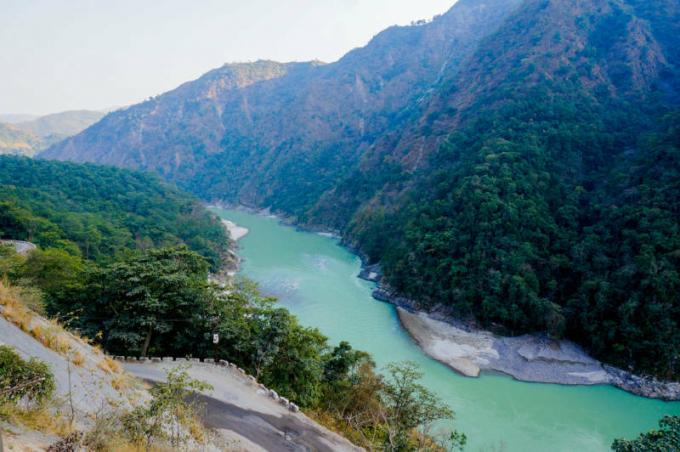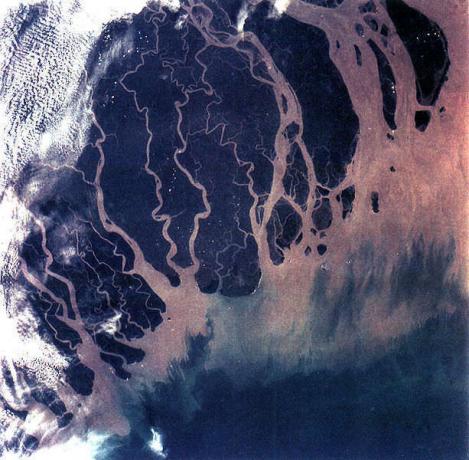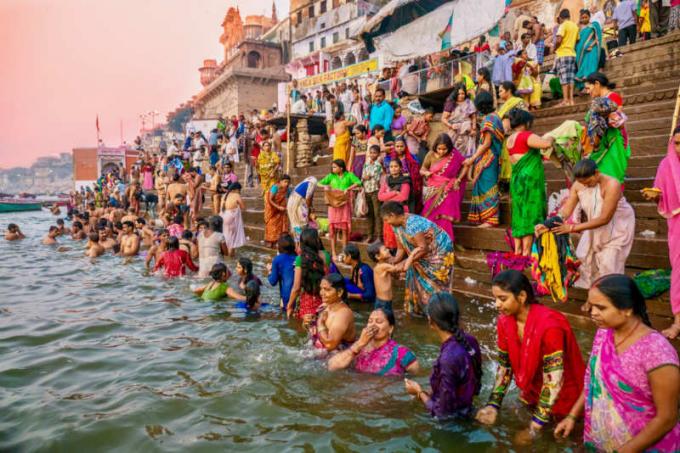O Ganges River is a river that flows between India and Bangladesh, in the South of the Asian continent. Its waters run 2,525 kilometers from the base of the Himalayan Mountains to the Indian Ocean, in the Bay of Bengal region. It is a river full of religious symbolism for Hindus, who believe that the Ganges River is the representation of the goddess Mother Ganga. A bath in the waters of this river would be able to purify and absolve sins, preparing the individual for salvation.
Despite the religious significance and importance that the Ganges has for the region, given that the its river basin is the most populous in the world, this river is also the most polluted of all the great rivers known. This aspect compromises the quality of its waters and limits the uses of the Ganges River.
Read too: Nile River — one of the largest water sources in the world
Summary about the Ganges River
The Ganges River is a watercourse located in the Indian subcontinent, which runs through the territories of India and Bangladesh.
Its river basin also includes China and Nepal. In total, it has 1,080,000 km² and more than 400 million inhabitants.
The length of the Ganges is 2,525 kilometers, running from northwest to southeast.
It is born from the confluence of the Bhagirathi rivers and the Alaknanda river, which, in turn, are formed from the melting of a glacier at the foot of the Himalayan Mountains.
It flows into the Indian Ocean in the Bay of Bengal.
The Ganges is a river considered sacred by followers of Hinduism, having great religious significance and importance in the region.
Its waters are important for the local economy, given the intense pilgrimage of believers and tourists.
Despite its religious and economic role, it is one of the most polluted rivers in the world, and its water quality is compromised.
Facts about the Ganges River
Location: South Asia, in the Indian subcontinent.
Countries: India and Bangladesh.
Length: 2,525 kilometers.
Source: situated on the Bhagirathi River, in the Himalayan Mountains.
Source altitude: 3,892 meters.
Main tributaries: Ramganga, Brahmaputra, Son, Gomati, Bagmati, Tamsa, Yamuna, Ghaghara, Meghna, Kosi and Gandak.
Mouth: Bay of Bengal (Indian Ocean).
Watersheds: Ganges Basin.
River basin countries: Bangladesh, India, Nepal and China.
What are the characteristics of the Ganges River?
The Ganges River is a watercourse that covers 2,525 kilometers in the west-east directionfurthe Indian subcontinent, located in Asia. The waters of this important river bathe the territories of India and Bangladesh, but its hydrographic basin comprises approximately one million square kilometers and, in addition to Indian and Bengali territories, covers also China and Nepal.
A The source of the Ganges River is located at the base of the Himalayan Mountains, between India and the Tibet autonomous region. This watercourse originates from the partial melting of the Gangotri glacier. More specifically, the waters that participate in the composition of the Ganges River are derived from the final (or posterior) portion of this ice mass, which is called Gomukh. The source area of the Ganges River is at an altitude of almost 4,000 meters, and is located in the Indian state of Uttarakhand.

Before forming the course of the Ganges, however, themeltwater dare the source of some of its main tributaries, which come together and form the sacred river of Hinduism. Among these tributaries is the Bhagirathi River and the Alaknanda River, which join together to form the Ganges River.
Initially, the Ganges River has a very intense flow as it originates in a mountainous region quite rugged relief. However, as it continues its flow, the Ganges River starts to bathe the Indo-Gangetic Plain, an extensive area of land with moderate altitude, which does not exceed 200 meters in altitude.
Even though the Ganges is the largest river in the country and one of the largest in the world, the its water regime, which is perennial, varies considerably according to the period of the year. This happens because the areas where this watercourse runs have a typically monsoon climate, characterized by a rainy season that causes annual rainfall to reach 3,000 millimeters in certain sections. Most of the rain occurs between the months of June and October.
The Ganges River It flows into the Indian Ocean, in the region known as the Bay of Bengal, through a delta mouth better known as the Ganges Delta. It is the largest delta mouth in the world, covering the entire coast of Bangladesh and part of the east coast of India.

Route of the Ganges River
To the waters that unite to form the Ganges River are born at 3,900 meters above sea level, approximately, at the base of the Himalayan Mountains, in the north of the Indian state of Uttarakhand, close to the Tibet region. It is in this area that the Bhagirathi river originates, which flows down to the city of Devprayag, where it converges with the waters of the Alaknanda River to then become one of the most important rivers on the Asian continent: the Ganges.
About 200 kilometers below its confluence point, the Ganges River reaches the Indo-Gangetic Plain, near the city of Haridwar, which is located on the right bank of the sacred river. Despite not bathing the Indian capital, the Ganges passes close to the New Delhi region, which is part of its river basin, on its way to the neighboring country. About 900 kilometers below its source, the Ganges passes through the city of Varanasi. There are many religious temples that were built on the banks of the Ganges, which is why this city is so important when we talk about religious pilgrimage.
Less than 250 kilometers ahead of Varanasi, just before reaching the city of Patna, the Ganges River finds some of its main tributaries, such as the Ghaghara and Son rivers, in the east of the territory Indian. Upon entering Bangladesh, the Ganges River becomes known as Padma. From then on, the Ganges crosses the country from northwest to south, where it flows into the Bay of Bengal. In total, 2,525 kilometers were covered.
Read too: São Francisco River — watercourse that bathes the Northeast known as the Brazilian Nile
Religious importance of the river Ganges
The Ganges, as we saw earlier, is a river considered sacred by followers of HHinduism. This is the official religion of India, still practiced by a large portion of the population living in the Indian subcontinent and South Asia. It is believed that the Hindu goddess Mother Ganga, or Mother Ganges, came down from the heavens to live in the waters of that watercourse. Because of this, the Ganges River would represent the materiality of the goddess worshiped by Hindus.

For representing Mother Ganga herself, the act of bathing in the waters of this river corresponds to a purification rite and the eradication of sins. Followers of this faith, notably Indians, must bathe in the Ganges River at least once in their lives to achieve salvation. Furthermore, the religious importance of the Ganges River is reflected in the various temples that lie on its banks and the funeral ceremonies that are held in its waters. Thus, there is the complete cycle of life and rebirth represented by the Ganges.
Pollution of the Ganges River
The Ganges River has the most populous river basin in the world, where there are intense urban and industrial activity that produces directly discarded waste, without any type of treatment, in the waters of nearby springs, including the Ganges River itself. This happens due to the lack of adequate infrastructure in many parts of India, mainly, but also in other areas supplied by the waters of the Ganges. This infrastructural deficit is concentrated in the urban sanitation sector, which includes the collection and adequate treatment of effluents.
You funeral rites, such as the disposal of ashes, which are carried out on the banks of the Ganges River contribute, in the same way, to the worsening of pollution of its waters. Still when it comes to the religious use of the Ganges River, many believers and tourists take objects and offerings that end up being deposited directly in the course of this source, which leads to a worsening of water pollution observed in the river Ganges. For all the factors we have seen, the Ganges is, today, the most polluted river in the world.
History of the Ganges River
The Ganges River is Mentioned as a sacred watercourse in the religious book Rigueveda, which was written between 1700 and 1100 BC. W. By crossing a wide plain region, the River Ganges, in addition to its sacred aspect, has also always been used for transport and navigation. Thus, records describing the physical characteristics of the river date back to the 15th century. It is important to mention, however, that the use of its waters for transportation and supply purposes It is made thousands of years ago.
There is evidence of irrigation systems that were built on the banks of the Ganges River in the 4th century BC. C., which denotes the use of the waters of this river for the development of economic activities such as agriculture. Over time, the Ganges River became one of the main rivers of the Indian subcontinent, fundamental for urban-industrial supply and primary economic activities.
Nowadays, however, the deterioration in the quality of its waters caused by intense pollution compromises the carrying out of some of these activities. Furthermore, navigation was partially interrupted, or rather, left aside when the railways appeared, especially when it came to passenger transport.
Curiosities about the Ganges River
In terms of flow, the Ganges is the third largest river in the world and the largest on the Asian continent. The water volume that passes through a section of this river is 18,490 m³/s.
The depth of the Ganges River varies between 16 and 33 meters.
In India, the Ganges River is also called Ganga.
This watercourse has many names, such as: Bhagirathi, Vishnupadi, Alaknanda and others.
The Ganges river basin is the most populous in the world: it is estimated that 400 million people live within its limits and depend directly or indirectly on the waters of this watercourse.
Image credits
[1] CherylRamalho/Shutterstock
Sources:
GOYAL, Shikha. What is the origin of holy river Ganga? Jagran Josh, 20 Mar. 2020. Available in: https://www.jagranjosh.com/general-knowledge/what-is-the-origin-of-holy-river-ganga-1536924684-1.
LODRICK, Deryck O. Ganges River. In: Encyclopaedia Britannica, [S.I.]. Available in: https://www.britannica.com/place/Ganges-River/Climate-and-hydrology.
NATIONAL GEOGRAPHIC. Encyclopedic entry: Ganges River Basin. Available in: https://www.nationalgeographic.org/encyclopedia/ganges-river-basin/.
QADRI, Altaf. Ganges River flows with history and prophecy for India. AP News, 11 Aug. 2020. Available in: https://apnews.com/article/ap-top-news-glaciers-international-news-photography-india-0a2dfe48fd4c9bbe48981f5b9a191e68.

